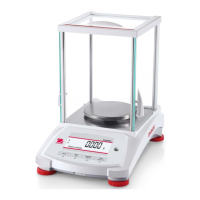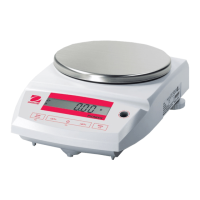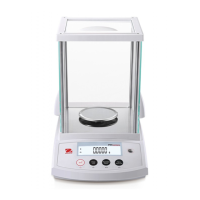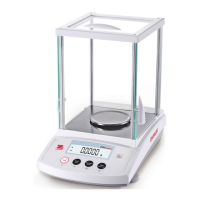Do you have a question about the OHAUS Pioneer PX85 and is the answer not in the manual?
Details the balance's display, applications, and overall capabilities.
Explains warning symbols, hazard levels, and critical safety precautions for use.
Steps for unpacking components and choosing an optimal installation location.
Instructions for ensuring the balance is level using the built-in bubble level.
Connects the balance to power and allows it to adjust to ambient conditions.
Details connecting RS232 and USB ports for data transfer.
Explains the necessity and types of initial calibration for accuracy.
Overview of the balance's display, main screen layout, and control buttons.
Describes basic weighing, taring, zeroing, and accessing the main menu.
Identifies key components and features of balances with draft shields.
Identifies key components and features of balances without draft shields.
Procedure for determining the weight of objects in the selected unit.
Method for counting samples of uniform weight using the balance.
Displays object weight as a percentage of a pre-established reference sample.
Weighing unstable loads by averaging readings over a set time.
Overview of determining object density using the balance and density kit.
Lists parts of the density kit and steps for preparing the balance for measurements.
Tips for improving accuracy, including accounting for air buoyancy and temperature.
Method for determining the density of liquids using a calibrated sinker.
Procedure for measuring the density of porous materials, often oil-impregnated.
Calculating wet density of a sample using the oil-impregnated part.
Step-by-step guide to measure the density of a sinking solid using water.
Procedure for measuring the density of a floating solid using water.
Measuring solid density using an auxiliary liquid other than water.
Steps to set the density of the auxiliary liquid for measurements.
Procedure to determine liquid density using a calibrated sinker.
Procedure to measure the density of porous materials using oil.
Configuring parameters like temperature, weight, and oil density for porous samples.
Instructions for utilizing the balance's weigh below capability for weighing items underneath.
Guides users on how to navigate menus and modify settings.
Introduces the available calibration methods: Internal, Span, and Linearity.
Details the calibration sub-menu specific to InCal models.
Step-by-step guide for performing internal calibration on InCal models.
Method for fine-tuning internal calibration results by adjusting divisions.
Procedure for performing span calibration using zero and full load points.
Procedure for performing linearity calibration using three calibration points.
Customizing balance functionality through various setup menus.
Setting the display language and adjusting the signal filtering level.
Configuring automatic zero tracking and automatic tare functions.
Setting the balance readability and adjusting display brightness.
Setting and formatting the current date and time.
Configuring automatic display dimming and the capacity bar feature.
Setting the balance for Legal for Trade status and its implications.
Choosing from the various units of measure available for weighing.
Steps to change units and define a custom unit with factor, exponent, and LSD.
Configuring baud rate, data bits, stop bits, and parity for RS232 communication.
Setting handshake protocols and introducing print data transfer settings.
Configuring print stability, numeric only output, header frequency, and destination.
Configuring automatic printing and header inclusion.
Enabling or disabling the printing of various data fields like date, time, ID, results, etc.
Setting up GLP headings, balance name, user name, and project name.
Resetting all settings to factory defaults and locking/unlocking menu items.
Verifying and sealing the balance according to local weights and measures regulations.
Using security switches and seals to protect balance settings.
Connecting, configuring, and testing the RS232 interface for printing.
Information on Ohaus SPDC software for data collection and transfer.
Details the structure and fields of the data output format.
Illustrates printout examples for various applications with default settings.
Guidance on periodically verifying calibration and cleaning the balance.
A table listing common symptoms, possible causes, and remedies.
Details operating ambient conditions, altitude, temperature, and materials used.
Table detailing specifications like capacity, readability, repeatability, and units for specific models.
Continuation of specifications tables, covering more models and parameters.
Further continuation of specification tables for higher capacity models.
Final part of the specification tables, including InCal Approval Models.
Provides dimensional drawings for different balance models.
Lists optional accessories with their part numbers.
Lists commands for controlling the balance via RS232.
Details the pinout and specifications for the RS232 DB9 connector.
Explains how the USB interface works, using a generic interface.
Step-by-step guide for connecting the balance to a computer via USB.
Information on obtaining and applying the latest balance software updates.
Lists compliance with EU directives (EMC, LVD, NAWI) and international standards.
Notes on FCC, Industry Canada compliance, and ISO 9001 registration.
Outlines the terms, conditions, and exclusions of the product warranty.











